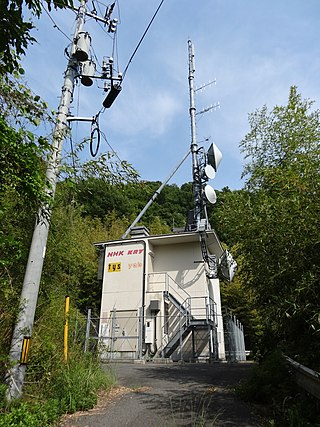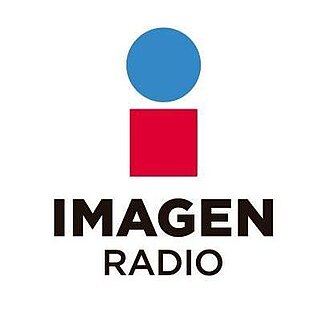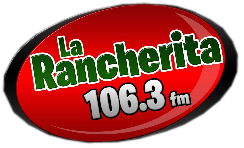
XHMNU-TDT is an educational television station owned and operated by the Universidad Autónoma de Nuevo León (UANL) in Monterrey, Nuevo León, Mexico.

XHUIA-FM is a radio station in Mexico City. Owned by the Universidad Iberoamericana through licensee Radio Ibero, A.C., XHUIA-FM broadcasts on 90.9 MHz and carries a mixed college radio format under the name "Ibero 90.9". The transmitter is located inside the Santa Fe campus of Universidad Iberoamericana.

A broadcast relay station, also known as a satellite station, relay transmitter, broadcast translator (U.S.), re-broadcaster (Canada), repeater or complementary station (Mexico), is a broadcast transmitter which repeats the signal of a radio or television station to an area not covered by the originating station.
XHUATX-FM is a radio station in Tlaxcala City, Tlaxcala, Mexico. Broadcasting on 99.5 FM from a transmitter on Cerro Ostol, XHUATX is owned by the Autonomous University of Tlaxcala and broadcasts a university radio format known as Radio Universidad.

Radio Universidad is the radio service of the Universidad Autónoma de Chihuahua in Chihuahua, Chihuahua. It broadcasts on XHRU-FM 105.3 FM and XHERU-FM 106.9 FM.
XEJB-FM is an FM radio station in Guadalajara, Jalisco, Mexico. Broadcasting from a transmitter located atop Cerro del Cuatro, XEJB-FM is owned by the government of Jalisco and carries a cultural radio format under the name Jalisco Radio.

Jalisco TV, virtual channel 17, is the public television network of the Mexican state of Jalisco, operated by the Sistema Jalisciense de Radio y Televisión alongside XEPBGJ-AM and XEJB-FM and broadcasting on transmitters in Guadalajara, Ciudad Guzmán and Puerto Vallarta. Its programming is primarily cultural and educational content.

XHRUV-FM is the radio station of the Universidad Veracruzana in the state of Veracruz, Mexico. It broadcasts from the state capital of Xalapa on 90.5 MHz. It uses the identification "Radio UV" and broadcasts a mix of news, cultural shows and classical music from its transmitter in Acajete, Veracruz. The station is on the air from 5 a.m. to 1 a.m.

XEDA-FM is a radio station in Mexico City owned by Grupo Imagen. XEDA-FM is the flagship station of the Imagen Radio news/talk network which is available to other Mexican cities through Imagen's owned-and-operated stations and affiliates.

Canal 44 is the television network of the Universidad de Guadalajara (UDG), a university in Jalisco, Mexico. The primary station, XHCPCT-TDT, broadcasts to the Guadalajara metropolitan area from a transmitter located on Cerro del Cuatro in Tlaquepaque, with additional transmitters in Ciudad Guzmán, Lagos de Moreno, and Puerto Vallarta. Canal 44 and the UDG's eight-station radio network form the Sistema Universitario de Radio y Televisión.
XEPBGJ-AM is an AM radio station in Guadalajara, Jalisco. Broadcasting on 630 kHz, XEPBGJ-AM is owned by the government of Jalisco and carries a cultural radio format under the name Jalisco Radio.
Radio Sonora is the state radio network of the Mexican state of Sonora. It serves 95% of the state through its 30 FM transmitters, making it the second-largest state radio network in Mexico.
Radio Universidad in Mexico is the radio service of the Universidad Autónoma de Yucatán (UADY), broadcasting in Mérida and Tizimín.

XHUSP-FM is a radio station in San Luis Potosí, San Luis Potosí. It broadcasts on 88.5 FM and is one of two radio stations owned by the Universidad Autónoma de San Luis Potosí, known as Radio Universidad 88.5 FM.

XETIA-FM is a radio station on 97.9 FM in Guadalajara. The station is owned by Unidifusión and is known as Fórmula Melódica with a romantic format.
XEAD-FM is a radio station on 101.9 FM in Guadalajara. The station is owned by Notisistema and is known as La Buena Onda.

XHIS-FM is a radio station on 106.3 FM in Ciudad Guzmán, Jalisco. It is known as La Rancherita and is operated by Grupo Radiofónico Zer. The station is simulcast on Zer-owned XHPTAM-FM 88.9 in Tamazula de Gordiano, which was won in the IFT-4 radio station auction of 2017.
XEHL-AM is a radio station on 1010 AM in Guadalajara, Jalisco, Mexico, known as Radio Cañón.

XHKB-FM is a radio station on 99.9 FM in Guadalajara, Jalisco. It is owned by Multimedios Radio and carries its variety hits format, La Lupe.
XHPBUG-FM was a radio station on 89.7 FM in San Andrés Cohamiata, Mezquitic Municipality, Jalisco. The station was owned by the Universidad de Guadalajara and operated locally with indigenous programming as a semi-satellite of its statewide network.












